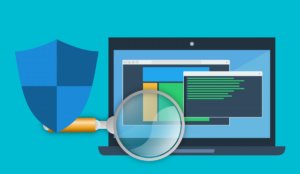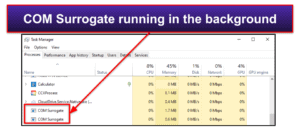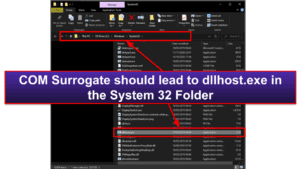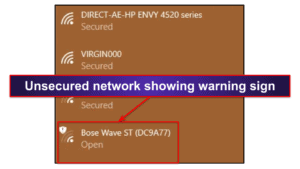How To Remove Background Processes Infection Malware

Short on fourth dimension? Here's how to remove the COM Surrogate virus:
1. Scan Device — Run a "Total System Browse" with a loftier-quality antivirus (Norton is the best).
ii. Remove Virus — After the scan is complete, let the antivirus remove all instances of the COM Surrogate infection.
3. Stay Protected — Protect yourself from further infections with a high-quality cyberspace security packet (once more, Norton is the all-time).
COM Surrogate is a normal Windows process, but hackers use fake versions of it to infect a PC while avoiding detection. The COM Surrogate virus is one of the most mutual malware infections on Windows computers — it's pretty dangerous, only getting information technology off of your PC really isn't very hard.
Notwithstanding, you should never try to delete the COM Surrogate virus manually.If you effort to remove the virus manually,you risk causing permanent damage that can lead to Windows ten failing completely.
The most efficient and secure way to remove the COM Surrogate virus is by installing a comprehensive antivirus suite. A expert antivirus volition not only quarantine and remove every instance of the COM Surrogate infection from your computer, but information technology will also ensure you remain safe from hereafter threats with its real-fourth dimension protection and scanning capabilities.
Quick Tip: Norton can exercise this, but it isn't free. However, you can purchase Norton, use it to remove the virus, and then return it with the company'due south 60-day money-dorsum guarantee.
Get Started Now — How to Remove the COM Surrogate Virus
Preliminary Step: Checking for a COM Surrogate Infection
This step is for advanced users who want aid in agreement malware diagnostics. If you lot simply want to remove the COM Surrogate infection (and other malware), skip ahead to acquire how.
If y'all want to check whether the COM Surrogate process running on your organisation is malware, yous must first empathise what the standard COM Surrogate process is.
COM is an acronym for Component Object Model and is related to dllhost.exe in your System32 folder .
In simple terms, it's a binary interface that communicates with different software and increases the software'due south capabilities. For example, when a folder on your Os needs to describe thumbnails, it will request COM Surrogate to exercise just that. This is why COM Surrogate is referred to as "middleware".
COM Surrogate is a pathway between applications, commands, and your operating organisation. It's important for your calculator's everyday functioning.
This is why hackers frequently disguise malware every bit middleware — they desire to get access to your entire system.
That said, here's how to know if you're looking at an authentic case of COM Surrogate or a dangerous piece of malware.
Bring up your Chore Director past hittingCTRL + Shift + ESC.

In the motion-picture show to a higher place, you tin can run into COM Surrogate is running twice on the system. While this may expect alarming, it's not. It simply means multiple applications are using the middleware to help them in communicating with the Bone.
To confirm this, y'all tin right-click on both instances and click Open File Location.
If they go to a file called "dllhost.exe" in the System32 folder on the arrangement, then it is unlikely they are malicious.

If the file is located anywhere other than dllhost.exe, then you have a virus and should follow my removal steps.
Step 1. Identify the COM Surrogate Virus With Your Antivirus (And Don't Brand the Problem Worse!)
Important : Do not connect your cell phone, tablet, or USB drive to an infected computer. In doing so, yous run a risk the virus replicating itself onto those devices.
Once y'all've downloaded a secure antivirus program, run a full deejay scan on your computer. Even if you think yous know where the infection started or y'all know where the suspicious .exe file is located, a full disk scan is best.
A full deejay scan will notice, quarantine, and remove every copy of the COM Surrogate virus, as well as ensure that your device isn't infected with any other malware, including spyware, rootkits, or worms that tin can frequently run undetected.
Recall: Run the full system browse until it's finished. Practice Not cancel the browse when yous meet the virus announced on the infected file list. There's no style of knowing how many other copies of it be in your organisation.
The full browse tin can have anywhere from ane–4 hours, so sit tight because your antivirus needs to analyze every single file and procedure on your computer.
When your antivirus has alerted you that the scan is complete,every case of malware on your system will be identified and quarantined — including the COM Surrogate virus.
You tin can now proceed to Footstep ii.
Step 2. Remove the COM Surrogate Virus Infection and Delete Any Other Infected Files
When your antivirus has identified and quarantined all of your compromised files, it will give you the option to delete them. Advanced users can get through the quarantined files and make certain in that location are no false positives before hit the Delete button. Simply most users will merely want to trust their antivirus software — if it'south been flagged as malware by a programme similar Norton, chances are you don't want it on your device.
Subsequently you've removed all of the compromised files from your arrangement, information technology'due south a good thought to restart your reckoner.
After y'all restart your device, run a 2nd total disk scan to ensure your antivirus has removed all traces of the COM Surrogate infection. This may not take as long during the second scan — many antiviruses, including Norton, call up which files they have already scanned and are able to analyze your disk much more chop-chop later the kickoff full disk scan.
As before, be sure to let your antivirus finish its second scan. Once the scan is finished, and you've reviewed and deleted all of the compromised files in your quarantine, you tin breathe a sigh of relief. Your device is 100% malware-free! For now…
Even though you've finished removing the COM Surrogate virus, there are still thousands of malware files out in that location that tin infect your devices, compromise your online accounts, and spread through your Wi-Fi network.
Step 3. Keep Your Device from Getting Re-Infected
Since the COM Surrogate virus has infected you once already, you've witnessed first-hand but how piece of cake it is to go malware on your PC.
New malware is released every day, and in that location's also the risk of online data harvesting, identity theft, and public Wi-Fi hackers.
In today's online earth, how can you proceed your devices and information condom? In that location are several things you can exercise:
-
Continue Your Software, Os, and Drivers Upward-To-Date
When developers find vulnerabilities in their software that are beingness exploited by hackers, they patch those vulnerabilities and send the patches to users in the form of software updates.
Software updates can be annoying, but they are essential to keeping your computer safe from the latest malware threats.
However, with the amount of devices, apps, and programs that near users are running these days, information technology tin can exist really hard to proceed rails of which programs demand to be updated. Ane cracking tool comes from the antivirus provider Avira — information technology lets you scan your PC for out-of-appointment software and automatically update information technology.
It's as well incredibly of import that you stay on the latest operating system and keep your drivers updated.
When an operating system ages, developers will cease supporting information technology. So whatever vulnerabilities won't be stock-still with updates. This means that older operating systems abound more and more vulnerable every twenty-four hours as hackers proceed to develop tools to infiltrate them.
Virtually operating systems and programs accept an auto-update choice. Wherever possible, select this option to make certain you lot're keeping all of your devices and organisation drivers up-to-date.
-
Don't Download Suspicious Files
Whether information technology'south from an email or a suspicious website, don't download files unless you lot're 100% sure you lot recognize where they're coming from. The vast majority of malware is delivered with seemingly legitimate costless software or information technology's fastened to deceptive emails — if you don't put malware on your computer, information technology's very hard to get infected.
Your antivirus tin help with this by scanning emails and tagging suspicious files, plus scanning all downloads earlier they can make changes on your reckoner. However, information technology's still all-time to practice common sense and avoid files from unknown sources.
-
Secure Your Wireless Network
Make sure your wireless network is secure earlier y'all go online. You can do this past using a firewall, but you lot should also ensure your home Wi-Fi connectedness is countersign-protected, likewise.
Y'all tin can encounter if a connectedness is password-protected by looking in your network list — the ones that aren't password-protected have a warning sign next to them.

Unsecured networks are far more vulnerable since anyone can connect to them, only hackers tin can infiltrate a secured network, as well.
Well-nigh people don't think to set their Wi-Fi router'southward countersign, and the default router countersign ends upwards beingness something like "password". This is a very easy countersign to guess, and hackers gauge these weak passwords and suspension into "password-protected" networks all the time.
To set up a password for your home router, you will need to log into your router's settings on a web browser and follow the instructions provided. When you purchased your router, you lot should have received instructions explaining how to practice this. If not, try typing the router'southward model number into Google.
Quick Tip: A condom password should be at least xv characters long and use a random mix of letters, numbers, and special characters. You can use a countersign manager such every bit Dashlane to store all of your passwords, so y'all won't take to worry about remembering your router's password.
-
Download a Secure Antivirus Program
In that location are a ton of antivirus packages on the market. However, there are but a few that are truly excellent, providing all of the security protections that you need to stay safe online. You tin bank check out 2022's best antivirus packages here.
I really like Norton 360 — it's a premium antivirus suite with one of the all-time anti-malware engines in the world, along with a ton of useful security protections. Norton's antivirus scanner uses artificial intelligence, avant-garde heuristics, and a massive malware database to keep malware off of your device.
Norton as well includes:
- Anti-phishing protection — Flags suspicious websites and protects you from online scammers.
- Firewall — Blocks hackers from entering your network.
- Virtual private network (VPN) — Keeps your internet usage bearding, preventing network attacks, spider web surveillance, and man-in-the-eye attacks.
- Parental controls — Protects children by using content filters, app and screen time schedules, YouTube monitoring, and even location tracking.
- Arrangement cleanup — Gets rid of junk files and increases system functioning.
- Password manager — Stores, generates, and auto-fills passwords, and then hackers tin can't steal them.
- Identity theft protection (US only) — Monitors credit reports, the night spider web, and breach databases for compromised accounts, and includes a $i million insurance policy.
Frequently Asked Questions about the COM Surrogate Virus
- Can I disable COM Surrogate?
- Why does COM Surrogate go along crashing?
- Where is COM Surrogate located?
- Why is the COM Surrogate virus unsafe?
Can I disable COM Surrogate?
You can't disable COM Surrogate. It's a cadre organization part within Windows that volition be called upon every time an awarding requests it.
I actually tested this by opening the Task Director on my reckoner and clicking "End Chore" on every case of COM Surrogate. I then opened a folder in File Explorer and switched to Thumbnail View. Every bit soon as I did this, COM Surrogate in one case once more appeared on my chore list.
This is normal, and it shouldn't be interfered with. COM Surrogate is a role of dllhost.exe's function and a required Windows groundwork process.
If in uncertainty, follow this guide on how to remove malicious instances of COM Surrogate.
Why does COM Surrogate keep crashing?
It's totally normal for COM Surrogate to crash occasionally. COM Surrogate is a sacrificial procedure. In fact, surrogate means to "human action in some other'southward identify".
For case, when y'all open up a folder and switch to Thumbnail View, Windows fires a COM Surrogate to describe those thumbnails within File Explorer. If, for whatsoever reason, this process crashes, instead of having the entirety of File Explorer crash, but COM Surrogate volition crash.
In other words, COM Surrogate crashing is aform of protection.
That existence said, consistent crashes or organization slow-downs may exist the symptom of something more serious. Should COM Surrogate crash oft, follow the above steps. Your reckoner may be infected.
Where is COM Surrogate located?
COM Surrogate is an internal procedure that is initiated by dllhost.exe — which is located in your System32 folder*.
COM Surrogate itself isn't something you lot can discover in your system files. Therefore, if you practise come across "COMSurrogate.exe" or anything similar, your figurer is probably infected with malware and you should check out the rest of my instructions for how to remove it.
*For the less tech-savvy users, the System32 folder is where Window's most important .EXE and .DLL files are located. If you were to delete System32, Windows would no longer function.
Why is the COM Surrogate virus dangerous?
The COM Surrogate virus is unsafe considering it tin open a backdoor into your system. Hackers tin can use that backstairs to break into your computer and steal sensitive information. This tin can include:
- Usernames
- Email addresses
- Passwords
- Bank account details
- Credit card information
The hacker will fifty-fifty be able to use the backstairs to download more than malware onto your arrangement. Trojans can also be used to hijack your operating system for botnets and cryptojacking malware. That's why it'south imperative that you remove all instances of the COM Surrogate virus, and any other malware that may have infected your system. If you don't know how to remove a virus from your PC, then check out the rest of my guide for removing COM Surrogate from your estimator.
About the Author
How To Remove Background Processes Infection Malware,
Source: https://www.safetydetectives.com/blog/how-to-remove-com-surrogate-virus-easy-steps/
Posted by: mcdowelllicand.blogspot.com




0 Response to "How To Remove Background Processes Infection Malware"
Post a Comment